What you need to know if you are still in doubt
What is a self-leveling floor and why is it also called self-leveling?


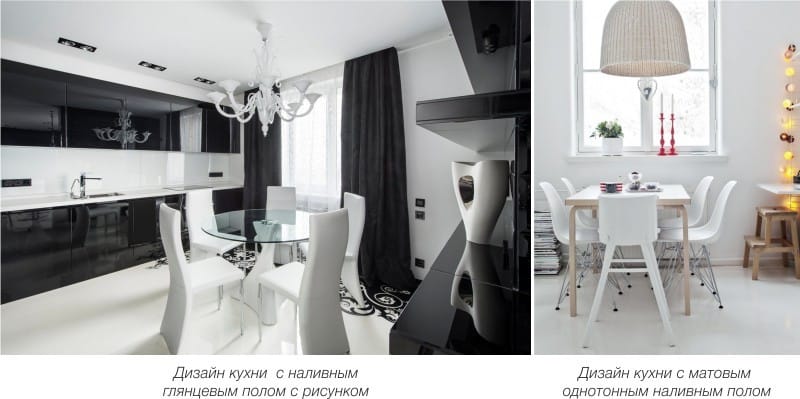
The self-leveling floor in the kitchen has a number of advantages over the more familiar coatings (linoleum, ceramic tiles and so on). Among them are such characteristics:
- Moisture resistance;
- Increased strength, long operational period, resistance to abrasion;
- Seamless;
- Ultraviolet resistance;
- Environmentally friendly - after pouring do not emit harmful substances into the air, bacteria and microbes do not settle on them;
- Fire resistance and stability at high temperature exposure;
- Immunity to chemicals - therefore, any means can be used for washing;
- High installation speed - no need to pre-level the base, and if you want to fill the floor with your own hands is not difficult, even for a beginner;
- Wide design range - from monochrome surfaces to 3D images, from matte to glossy textures. Due to the decorative layer or acrylic chips under the epoxy / polyurethane layer of the self-leveling floor, you can create a marbled or stone floor.
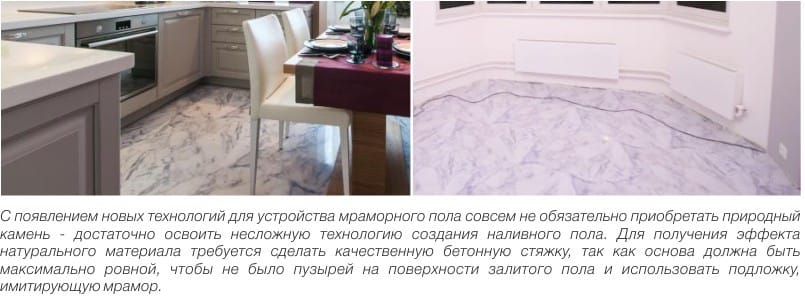
Disadvantages:
- The service life is very long - it is both a plus and a minus, as a self-leveling floor (especially floors with a bright and complex design, for example with a 3D effect) can quickly get bored;
- The polymer floor has high strength, which is also good on the one hand and dismantling on the other;
- Some species eventually turn yellow when exposed to ultraviolet radiation from the sun;
- It is necessary to carefully control the humidity of the base during operation;
- Bulk floor is an artificial material that not everyone likes.
- Polymer floor is colder than laminate or linoleum, but not colder than tile.
Choosing a design - photo of self-leveling floors in the interior of the kitchen
Bulk floor can be entered into any interior, but most of all it is suitable for finishing the kitchen in a modern style - Scandinavian, modern, hi-tech, minimalism and, of course, in the loft and industrial.
But for classic cuisine matte monochromatic or imitating stone or wood coatings are more suitable.
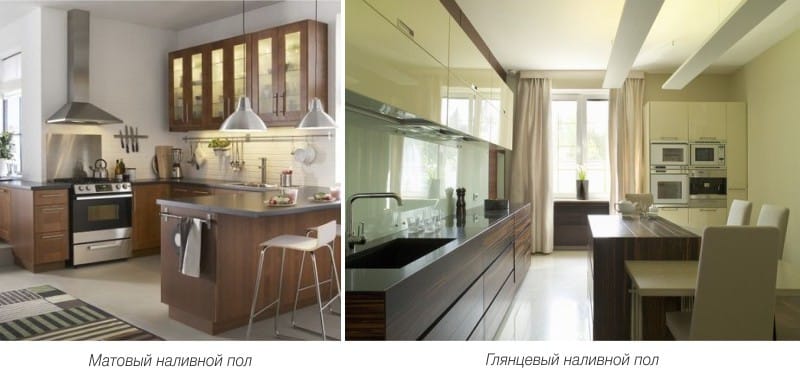
For finishing minimalist and high-tech kitchens seamless self-leveling floor - the best solution. It must be monotonous glossy or matte.
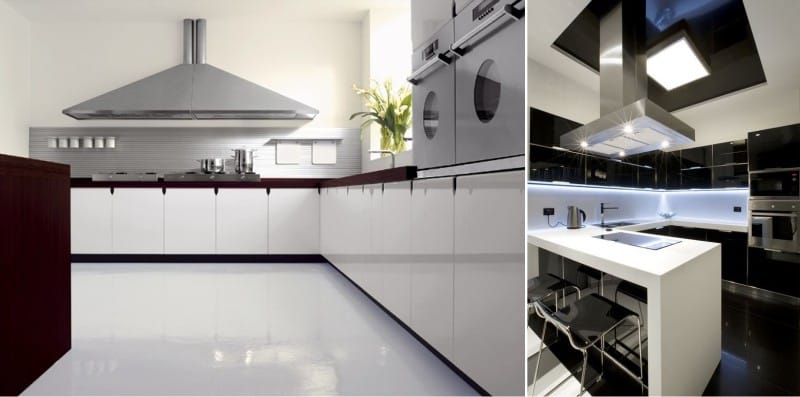
AT Scandinavian style The kitchen floor design should also not be intricate, the best color is white, but you can choose brighter or more contrasting colors. Or leave the floor in the form of draft screed.
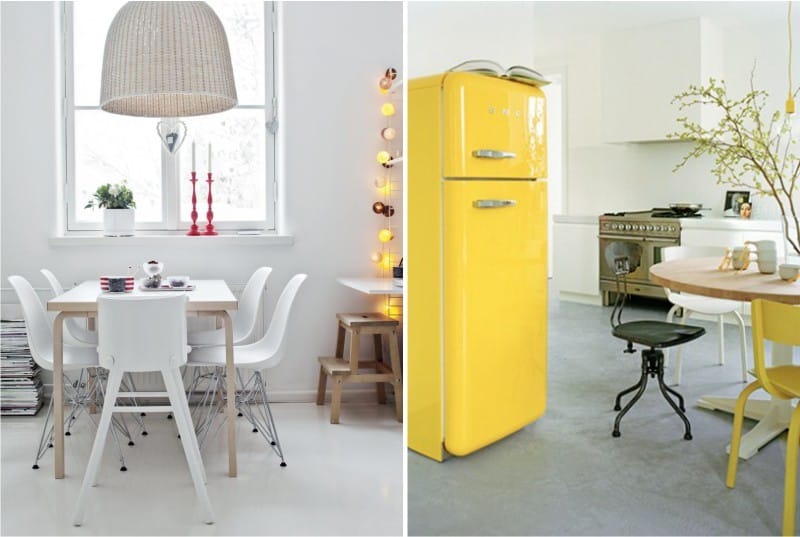
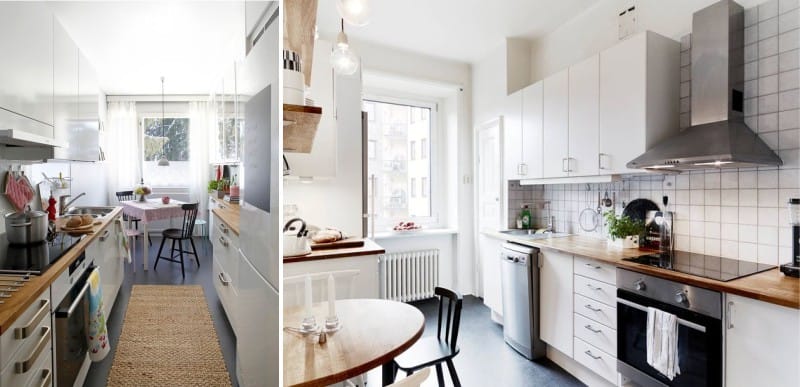
Bulk floor in the interior loft style kitchens and industrial should not be decorative. A tie without gloss in this design will be more appropriate.
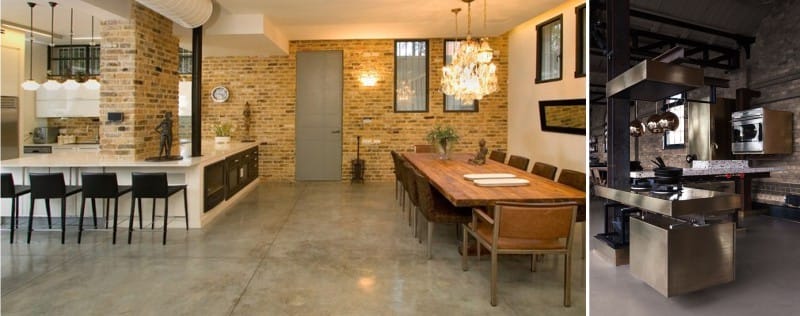
AT modern modernity Gloss is most appropriate. Glossy self-leveling floor should be monochromatic neutral colors.

Neutral, universal and win-free self-leveling floors - matte surfaces of white, milky, gray (concrete) and brown (wood) color. Keep in mind that the white color is not the most practical, but it is he who visually makes the kitchen brighter and more spacious, and also will be the perfect backdrop for both bright and for the strict design of the kitchen.
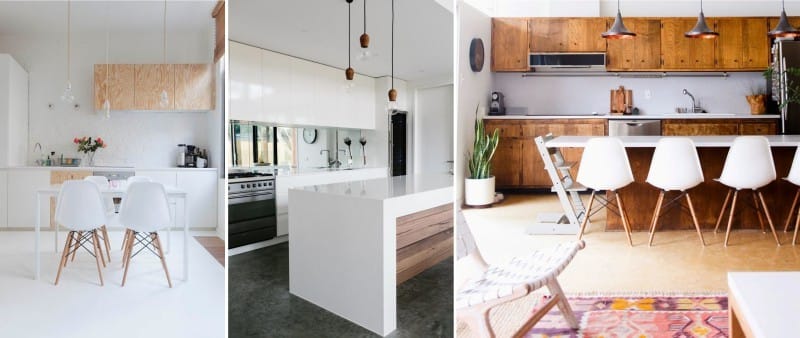
With a complex design of floors with pictures and, especially with the effect of 3D, you need to be very careful. Such elegant floors create a feeling of confusion, visually make the kitchen smaller, oblige the restrained design of the rest of the kitchen, and most importantly, they quickly get bored.
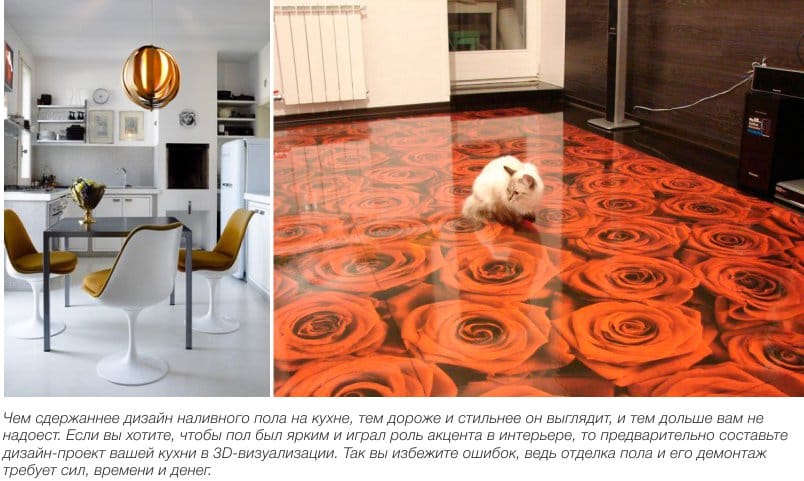
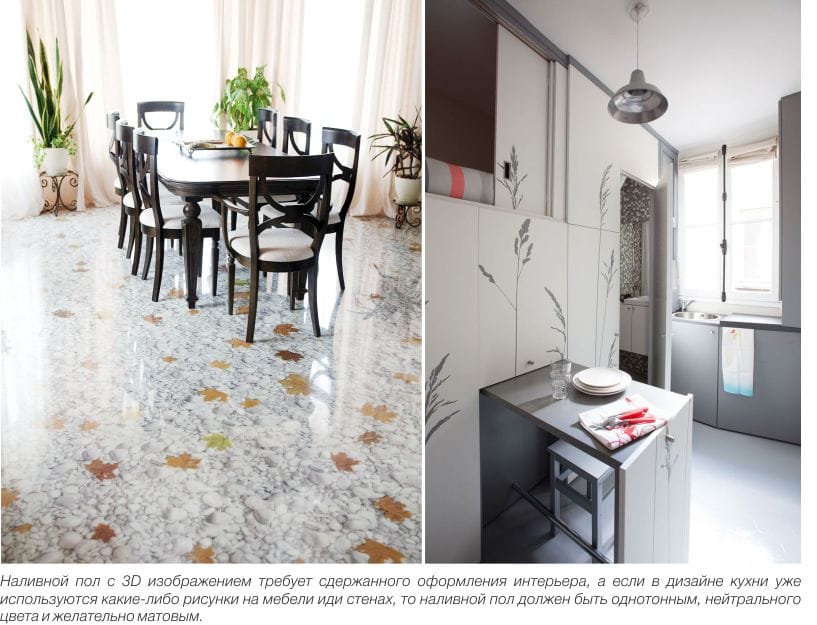
The choice is made - we start the work with our own hands.

In addition, before the process of creating a mixture and pouring it is necessary to prepare:
- Lighthouses - guides that will fill the floor. They indicate the level of the fill, as well as provide a flat surface. In addition, they provide the necessary gap between the floor and the walls. Most often, wooden strips are chosen as beacons.
- To work will require a supply of water After all, the prepared mixture hardens very quickly.
Filling your own floors, add more water in the bath. So you will be insured against unforeseen interruptions in water supply.
- Professional shoes with nozzles, spikes, so-called "cats". Nozzles with steel spikes allow a person to move across the freshly flooded floor without a trace.
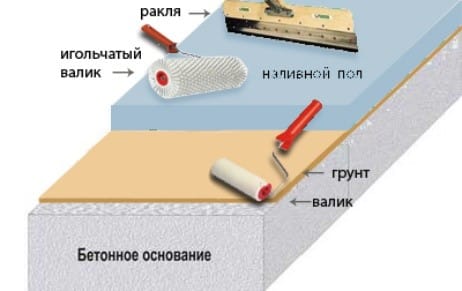
Works on self-pouring self-leveling floors are best done with a partner. After all, the prepared mixture dries very quickly, and the two of you can work at an accelerated pace.
Properly prepare and ground the base
How to make a self-leveling floor? The first step is to prepare the foundation. It can not be leveled "in the plane", but it is necessary to clean it from oil and glue spots, debris, dust. Otherwise, the self-leveling coating will not be able to fully adhere to the base and air bubbles will remain.
It is mandatory to close up cracks and discontinuities in the old coating. This is especially true of wooden floors. If this is not done, then the composition of the entire "leak" through the cracks.
It is worth considering that the self-leveling floor has excellent self-leveling properties, but it still will not hide significant height differences. Therefore, in some cases, still need to perform a tie. Also, it is important to measure the moisture of the base.
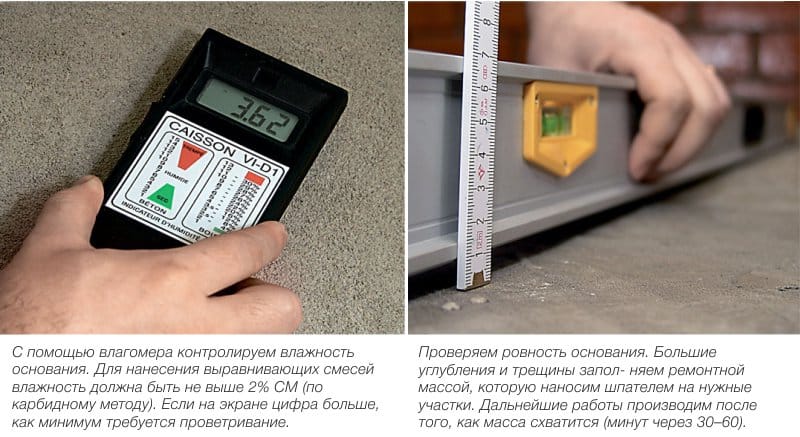
After the base is cleaned, it must be primed, and especially carefully apply a primer mixture in the corners of the room. What primer will do? Choose a universal film-forming primer or a deep penetration primer, if the base is moisture-absorbing. You can determine this by pouring some water on the surface - if the water is absorbed quickly, then a primer of deep penetration is better. If in doubt, take the universal.
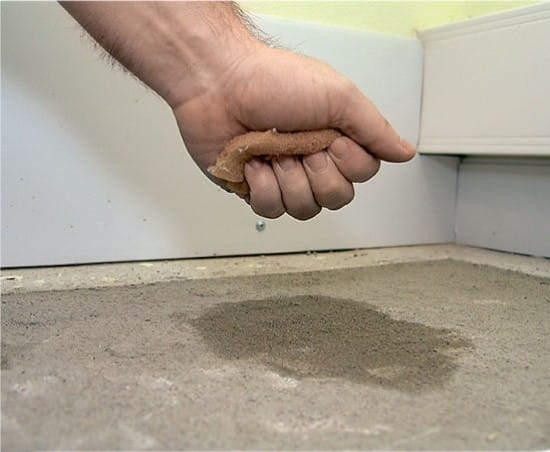
In the future, this will allow to avoid defects. The primer remains to dry for 24 hours - after that you can start work.
Cooking the mixture and pour the floor
So, how to make a self-leveling floor with your own hands? As noted earlier, self-leveling mixtures differ in composition, and each of them has its own characteristics and cooking rules. Therefore, diluted composition consisting of two interacting components, in strict accordance with the instructions presented on the package.
Important:
- The mixture must be stirred very carefully, paying special attention to the corners of the container so that there are no elements left unreacted;
- It is necessary to just pour the mixture into the water, and not vice versa. Otherwise there will be lumps in the mixture.
The result should be a homogeneous viscous mass. Now you have 20-30 minutes to get started.
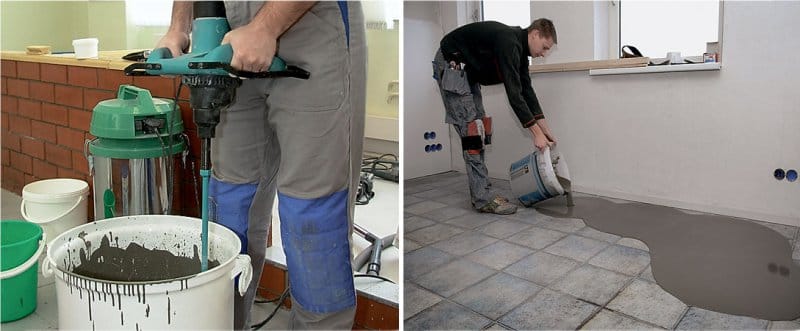
The mixture is poured on a clean surface and spread over the base with a squeegee or spatula. The distributed mixture is rolled several times with a needle roller, carefully eliminating air bubbles.

Rolling should stop at the moment when you notice an increase in the viscosity of the mixture.
Fill the mixture produced immediately over the entire area of the kitchen. Therefore, you need a partner - one will apply the mixture, and the second - to prepare a new composition.
To obtain high-quality kitchen cover is recommended to fill in two stages. Thus, the overall characteristics of the coating are improved. First form the base layer and leave it to dry for several days. After that make the fill of the finishing layer.
The base layer hides all the main "errors" of the base, so it is done with increased thickness. The finishing layer, unlike the base layer, is only a few millimeters thick. And only after the top layer is completely dry, a protective coating layer is also applied on top. It is important to apply varnish without gaps, on the entire surface completely. After all, the finishing top layer has nothing to do with protection, and if you do not apply varnish, then ugly scratches will appear on the floor very quickly.
As for the drying time of the coating, it is indicated on the packaging - the manufacturer's recommendations should be maintained completely. Until the coating dries out, it is necessary to avoid any significant effects on it - and direct sunlight, and significant temperature changes, and high humidity, and directional mechanical effects.
How to decorate self-leveling kitchen floors
Since the self-leveling floors in the kitchen are applied in two layers, between them you can put an image on special paper or you can decorate the base layer with acrylic or polymeric paints (using aerography technique). Between the two layers of the self-leveling floor can be placed both pebbles and sand or special acrylic chips.
Here is how the decorative self-leveling floor with a pattern is formed.
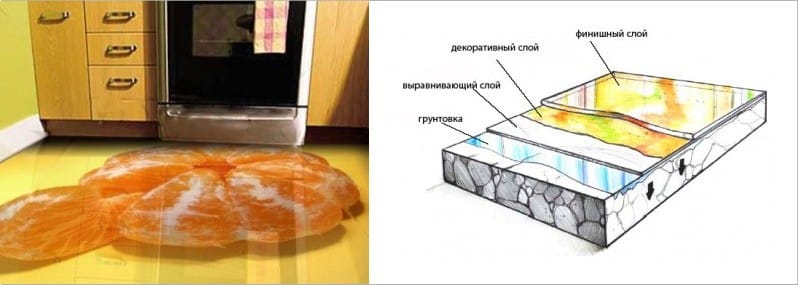
And this is how the device of a polymeric floor with a substrate of acrylic chips looks like.
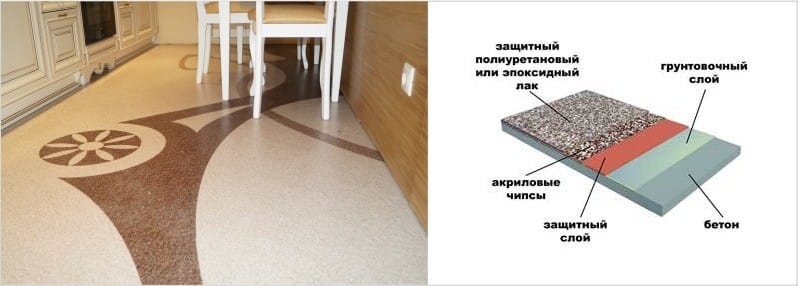
- Gender is relative: choose flooring for the kitchen
- Floorboard in the kitchen - all the pros and cons
- Cork flooring - 99% ideal floor covering for the kitchen
- All about linoleum for the kitchen
- Everything about laminate flooring in the kitchen - from choice to installation
- Porcelain tiles in the kitchen - 99% perfect floor



 (Rate the material! Already voted:12 average rating: 4,83 from 5)
(Rate the material! Already voted:12 average rating: 4,83 from 5)
Analyzing what I read, I am increasingly inclined to think that
self-leveling floor is the perfect solution. It is only important to provide options for it.
heating. Just won the diversity of ideas for the 3D effect. Until now, about this even
did not suspect. Very interesting article.
Julia, thank you. Glad the stuff came in handy.